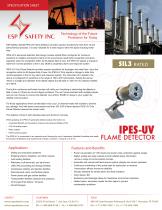
Catalog excerpts

SPECIFICATION SHEET Technology of the Future Protection for Today ESP Safety’s Model IPES-UV Flame Detector provides superior sensitivity for fires from oil and petrochemical products. It is also indicated for a wide range of other fire types including metal fires. IPES-UV’s advanced detection technology includes optical filters configured for maximum sensitivity to radiation produced by flame or fire and ensures rapid flame recognition and alarm signaling. Upon fire recognition within its 90-degree field of view, the IPES-UV signals a change in state from normal operation to fire in any OEM or proprietary alarm and response system. IPES-UV Only Flame Detector provides superior sensitivity for hydrogen and metal fires. Upon fire recognition within its 90-degree field of view, the IPES-UV Only signals a change in state from normal operation to fire for any alarm and response system. For ultraviolet (UV) radiation, the device is configured for sensitivity in the range of 180 to 250 nanometers, making the sensor “blind” to sunlight and radiation from heated objects but still able to “see” the UV radiation emitted by a flame. The built-in continuous self-check function will notify you if anything is obstructing the detector’s field of view or if there are circuit integrity problems. The unit comes standard with multiple outputs and you can choose to connect the detector via 4-20mA, RS485 or relays to your system for reliable communication. For those applications where condensation may occur, an internal heater will activate to prevent any damage. And with power consumption less than 3W, ESP’s flame detector IPES-UV Only Flame Detector assures low power costs. The detector comes in both stainless steel and aluminum housing. While operating, the IPES-UV generates detector-status information via: • A standard RS-485 communication channel under protocol Modbus RTU • 4-20 mA analog output • Relay outputs • HART Communication The IPES-UV is constructed in an explosion-proof housing for use in hazardous (classified) locations and meets the industry certifications and requirements of Class I, Division 1, Group B, C & D, T5. FLAME DETECTOR • Drilling and production platforms • Power consumption of <3W means low power costs, protection against surges • Digital, analog and relay outputs provide reliable status information across a range of communication formats • Automatic and manual self-tests ensure system integrity and correct operation • Continuous monitoring of the optical path for obstruction or reduced transmission affords maximum reliability • Industry standard for remote alarm and fault indication • Shipping tankers, freighters, and other vessels • Fuel loading facilities • Refineries, bulk terminals, and tank farms • LNG/LPG processing and storage facilities • Compressor stations and pipeline facilities • Petrochemical, paint, and fertilizer plants • Power plants and gas turbine facilities • Transportation facilities (airports and subways) • Oil and gas fired boilers / furnaces • Aircraft hangars • Color status LED • Explosion-proof package allows for hazardous environment operation • Heated optics, secondary heater function helps to prevent condensation problems 555 N. First Street | San Jose, CA 95112 Ph: +1-408-886-9746 | Fx: +1-408-886-9757
Open the catalog to page 1
info@espsafetyinc.com Response: Very High Sensitivity Size Field of View The detector has a 90° field of view (horizontal) with the highest sensitivity lying along the central axis. * 120° field of view version available by request Viewing Angle Electrical Characteristics Voltage < 2.0 W, standby < 3.0 W, during alarm < 5.0 W, self test < 7.3 W, maximum with heated window & alarm Fault signal Ready signal Fire signal Test Mode 3) Relay: Fire: - normally open/normally closed (NO/NC) user selectable - latching/ non-latching Fault: - normally open/normally closed (NO/NC) user selectable...
Open the catalog to page 2All ESP Safety catalogs and technical brochures
-
UPES
2 Pages
-
TGAES
2 Pages
-
SGOES
2 Pages
-
IPES IR-UV
2 Pages
-
IPES IR3
2 Pages






